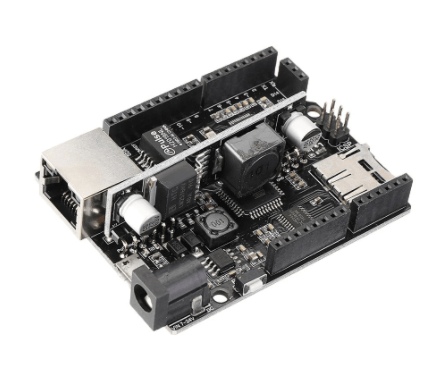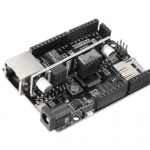
introduction
features
Product Overview:
If you're looking to build a network-connected device, RobotDyn Leonardo ETH(V2) is the best solution for you!
Leonardo ETH(V2) is a fully-featured Ethernet-connected device. Depending on your use case, it can act as a server or a net member. In a server role, it will receive requests from other devices and services in local network and internet, and respond or react accordingly. In a net member role, the RobotDyn Leonardo ETH(V2) can collect data from different devices or industrial equipment and send it through the local network or Internet. It can also receive data from local network and internet, and control connected devices and equipment. The RobotDyn Leonardo ETH(V2) can also act as stand-alone unit, providing autonomous reaction based on the defined algorithm in response to network changes or other triggers.
Leonardo ETH(V2) features two devices on one board: Leonardo based on an ATmega32U4 and Ethernet controller based on WizNet W5500 TCP/IP. It also has an optional PoE function (receiving power directly through the Ethernet cable).
W5500 Ethernet:
WizNet W5500 is a TCP/IP embedded Ethernet controller. It provides TCP/IP Stack, 10BaseT/100BaseTX Ethernet with full or half-duplex, MAC and PHY. W5500 is using a highly efficient SPI protocol, with 80 MHz clocks for high-speed connectivity to Atmega32U4. For lower energy consumption, W5500 provides WOL (Wake on LAN) and Power Off modes.
Ports and buses:
Leonardo ETH (V2) has 23 digital input/output ports, seven of which can be used for PWM, and 12 analog ports with 10-bits resolution (0 - 1023). 5 ports have a hardware interrupt feature. The board is equipped with an RJ45, micro USB, DC power jack, and a reset button. Unlike the other Leonardo ETH clones, Leonardo ETH(V2) has three additional digital SPI bus ports D14, D15, D16, which can be also used to communicate with other devices via SPI.
SD-card:
The board also features a microSD card socket. A microSD card can be used to save and store the data, which can later be transferred over the network. Digital port D4 (CS-CS2) of the ATmega32u4 is dedicated to work with the microSD. Digital port D10 (SS-CS2) is used by WizNet W5500. The Ethernet controller and microSD card are connected through the SPI bus, which is brought out as a separate ICSP connector with ports D14, D15 and D16.
HID functions:
Leonardo ETH(V2) can also act as an HID device. It can be used as a mouse or keyboard on the connected computer, in addition to the CDC sequenced/COM-port. You can program it to control an application on your PC. For example, you can set it up to turn your PC on, and then launch and control certain applications. The board itself can start an Arduino IDE, open a sketch and start the compilation/upload.
Programming in Arduino IDE:
Leonardo ETH(V2) can be programmed via an Arduino IDE. Select Arduino Leonardo or Leonardo ETH in the В«BoardsВ» menu, and use the Ethernet2 / Ethernet3 library.
Power supply:
Leonardo ETH(V2) can be powered via:
USB port (5V, 500mA);
DC-IN Jack, PWC 2.1mm, (supporting 7-24V DC input voltage);
Through an Ethernet cable using PoE (Power over Ethernet) - requires a PoE-enabled switch or a PoE injector.
Note:
With PoE version: this item, without PoE version: Product ID 1660664
The PoE module is optional. There are several PoE options available, depending on the PoE equipment you use.
The Active PoE is compliant with 802.3af or 802.3at. It will check the power coming in, and, if it doesn’t meet the device requirements, it just won’t power up.
The Passive PoE is a simplified version that does not perform a handshake, so it is important to know what PoE voltage your device supplies requires before plugging in the Ethernet cable and powering it up. If you connect the wrong voltage you may cause permanent electrical damage to the device.
Make sure to select the correct board option with a relevant PoE module.Specifications:
| Leonardo ETH V2 | |
| Input Voltage (VIN/DC jack) | 7~24V |
| Power IN (USB) | 5V-limit 500mA |
| Power IN (PoE) | Optional module, 48V(Input), 9V(Output) |
| Digital I/O | 23 |
| PWM Output | 7 |
| Analog I/O | 12 |
| Reserved Pins | D4 is used for SD card select; |
| D9 is used for SD card detect; | |
| D10 is used for W5500 | |
| D14, D15, D16 are used for SPI. | |
| *Optional: D8 is used for W5500 interrupting, D11 is used for W5500 initialization | |
| USB socket | Micro-USB |
| Ethernet socket | RJ45 |
| PCB Size | 53.3×68.6mm |
| Card Reader | Micro SD card, with logic level convertor |
| Weight | 41g |
| Leonardo MCU | |
| Microcontroller | ATmega32u4(AVR) |
| Operating Voltage | 5V |
| Flash memory | 32KB of which 4KB used by bootloader |
| SRAM | 2KB |
| Clock Speed | 16MHz |
| EEPROM | 1KB |
| Ethernet MCU | |
| Microcontroller | Wiznet W5500 |
| PHY compliance | 10BaseT/100BaseTX Ethernet. Full and half-duplex |
| Operating Voltage | 3.3V, 5V I/O signal tolerance |
| Memory | Internal 32Kbytes Memory for Tx/Rx Buffers |
| TCP/IP Protocols | TCP, UDP, ICMP, IPv4, ARP, IGMP, PPPoE |
| PHY Clock Speed | 25MHz |
| Passive PoE (optional) | |
| Ethernet Power (IN) | 12~48V DC |
| Output | DC 9V |
| PoE type | Passive PoE |
how to use


COMMENTS